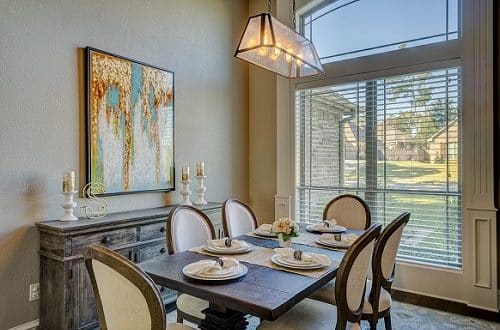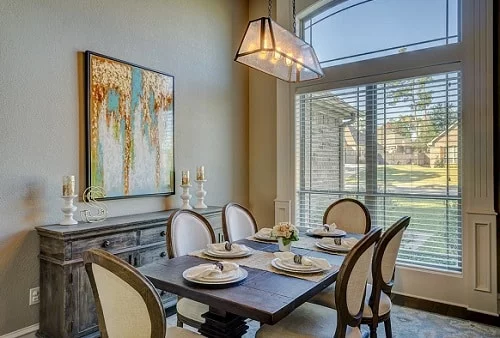Feng Shui Your Dining Room
Imagine a dining room full of light, harmony, and warmth — a place where family and friends gather for nourishment and conversation. The light is ample but gentle, and the spaces generous but not overbearing. The dining room is a central gathering place in a home and can be designed according to Feng Shui principles to promote overall good feelings and a positive dining experience. Let’s find out more about the best Feng Shui for your dining room.
Feng Shui, translated as “wind and water,” is the art of optimizing the flow of essential life energy, or “chi,” in living spaces. When a room’s flow of energy is directed naturally and harmoniously, humans feel at ease in the room and have a sense of security and peace.
From a Feng Shui perspective, a well-designed dining room can encourage proper digestion! Incorporating the life-affirming elements of Feng Shui into the design of your dining room and home can make your home a supportive, aesthetically pleasing place in which to live.
Producing the design does not have to be difficult or expensive. It is more a question of mindfulness in the arrangement of the room and the selection of its furnishings. Though there are many aspects of Feng Shui for home, designing a dining room can be simplified to 7 tips.
#1. Table and Chairs
The dining table must be of a size that is comfortably proportional to the room’s dimensions. The table should have enough space around it so that guests can walk around the table or stand behind their chairs. A table that is too large for the room imparts a feeling of confinement and causes tension.
Recommended shapes for dining tables are round and oval, as these shapes easily conduct chi. Square or rectangular shapes block the chi at the corners. If you want to use a square table, then balance it with accessories such as a round or oval rug and a round centerpiece. Feng Shui experts suggest placing 6 or 8 chairs around the table if the table size and room size allow.
Chairs should have a sturdy back and be round at the top. In Eastern cultures, the number 6 is believed to cultivate good luck, wealth, and prosperity. The number 8 is also associated with good luck and is believed to impart the order of the natural world, as in the eight directions of the compass.
The dining room mirrors the prosperity of the household, for an abundance or lack of food can indicate this. The dining room table is best situated on a diagonal across a square or rectangular room.
This allows chi to flow in a gentle, curving path around the room. Suggested materials for dining room furniture are wood or metal. Marble and glass can harbor negative chi in dining areas. In setting the table, consider that plain, colors and simple shapes provide the calming energy needed for relaxation. If the plates must have a pattern, keep it to one or two colors.
#2. Seating Arrangement
When seated at the table, the host should never have his or her back facing the door. The guest of honor should sit in a position opposite the door and have a good view of the windows. This is the most secure and anchored position. In the Feng Shui tradition, females typically sit in the south or west direction and males sit in the north or east direction.
#3. Color Feng Shui For Your Dining Room
The color scheme of a room is integral to its design. Colors reflect light and affect the living things that perceive them, influencing mood, energy, and behavior. In Feng Shui, groups of colors represent the five elements of nature — earth, air, fire, metal, and water. The colors of the earth promote relaxation and are considered compatible with dining.
Earth tones are grounding, motherly, reliable, and comfortable. These include colors such as terra cotta, brown, and amber, as well as other colors found in nature such as sky blue, green, and peach. Vivid colors are overly stimulating and may distract guests from dining and conversation.
As long as the primary color scheme is relatively neutral and relaxing, bold colors can be added to the room through accent items like tablecloths, napkin rings, and napkins.
#4. Accessories
A room’s accessories complement the primary shapes and colors of the interior design. Some accessories such as rugs, curtains, and wall art support dining, while other items such as wall calendars detract from the experience.
A thick rug made of natural fibers is ideal for the dining room and is best placed under the table. Rugs are grounding and stabilizing, encouraging guests to feel welcome and unhurried. Curtains made of natural fibers such as silk, linen, or cotton add beauty to the room and absorb noise.
Tablecloths, as opposed to placemats, are suggested for unifying the people seated. Wall art, especially landscapes and flower photos or paintings can be placed on a wall. It is best to keep other furniture to a minimum in the dining room to avoid crowding or distraction.
A single sideboard or buffet situated on one wall is acceptable. A centerpiece can be placed on the table as long as it is not too tall and does not cause overcrowding. A bowl of fresh fruit indicates abundance.
Place a mirror on a wall to double the table’s abundance and good chi. Make sure that the mirror reflects the table itself. Do not include clocks and calendars in dining room decor because they remind guests of the passage of time and discourage relaxation. As in all rooms, avoid cluttering the dining room. Clutter interrupts the flow of chi and devitalizes the room.
#5. Lighting
Lighting is an essential element in good dining. The light should be even and warm, just as the food should be. Outdoor light from skylights and windows is excellent. Install a central light fixture such as a chandelier as long as it is centered over the table.
In a large room, you can place additional sconce lights around the walls. Full-spectrum incandescent light bulbs include the warm colors of the spectrum and are preferable to fluorescent bulbs.
#6. Plants Feng Shui For Your Dining Room
Live plants increase the life energy in a room and benefit all decorating schemes in Feng Shui. To increase the chi and good luck in your dining room, place a few large, soft-leaved plants in the room. The only plant to avoid in Feng Shui is the cactus. Place plants ideally in the southern and eastern directions.
#7. Flowing Water
The element of water is part of the Feng Shui expression itself, “wind-water,” and is essential to life. The flowing quality of water is an excellent metaphor for the flowing quality of chi in Feng Shui. Water itself, images of water, mirrors, and glass all produce healing, renewing the energy of this element.
A flowing fountain makes a lovely addition to a dining room, patio, or kitchen. The flowing water adds to the area’s chi and also soothes the chi of its human occupants.
Place fountains and water features in the north, east, and southeast directions. Glass vases in clear or blue colors also evoke the therapeutic qualities of water, as do murals of lakesides or seashores.
See Also:
 Sun Signs Everything Under The Sun!
Sun Signs Everything Under The Sun!

